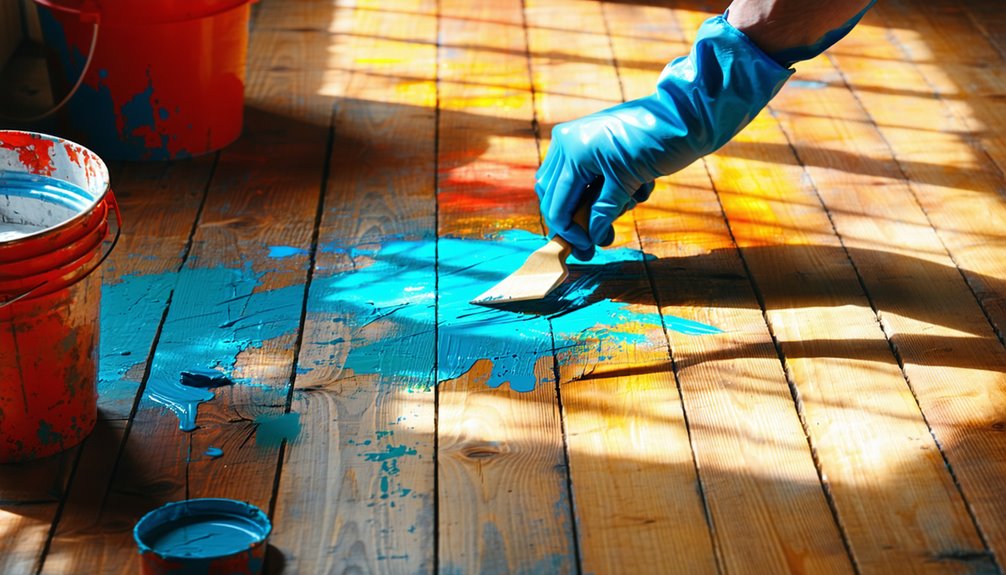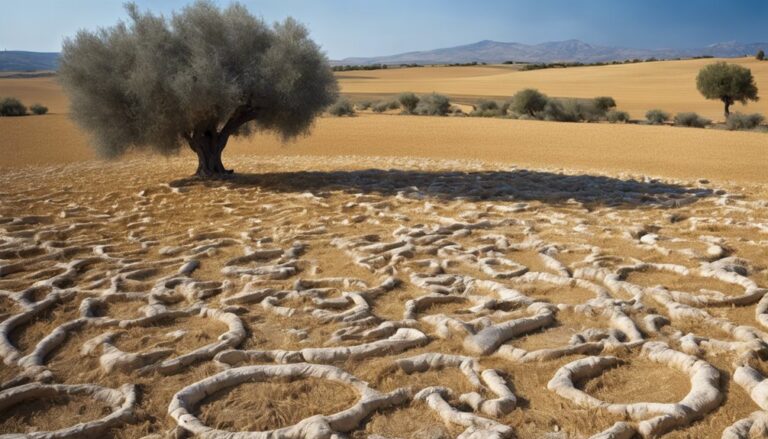To get paint off your wood floors, start by evaluating the damage and choosing the right tools, like a putty knife or a heat gun. Test different removal methods on inconspicuous areas using solvents or natural solutions. If stubborn paint remains, consider using a chemical paint stripper or an orbital sander for more extensive removal. Always wear protective gear and guarantee proper ventilation. After removing the paint, clean the area and smooth any rough spots. Finally, set up drop cloths for future projects to prevent spills—there's plenty more to explore for maintaining your floors effectively.
Assessing the Damage
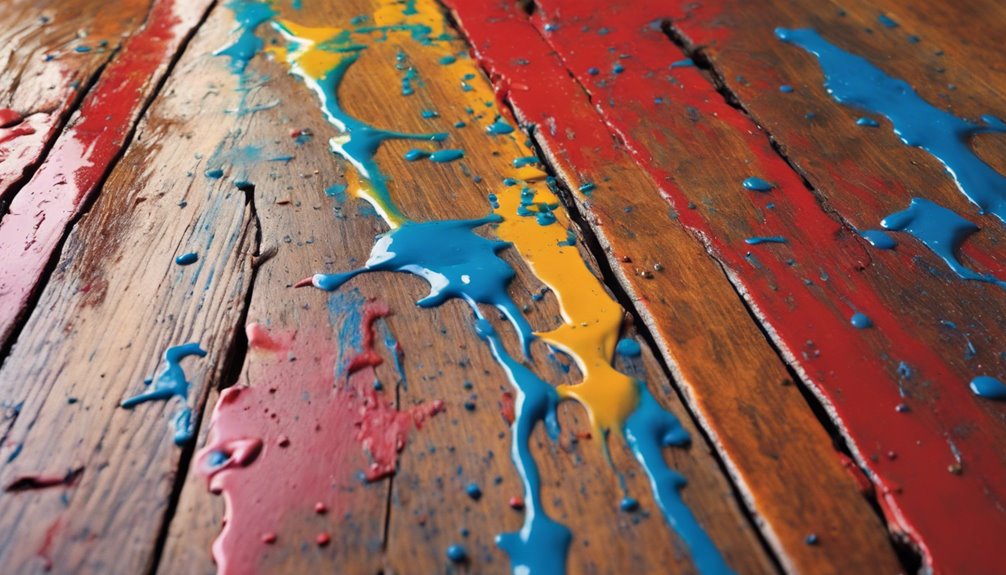
Before diving into the removal process, it is crucial to assess the damage to your wood floors. Start with a thorough damage evaluation to determine how the paint has affected the floor condition. Check for scratches, discoloration, or deeper penetration of the paint into the wood. Carefully inspect corners and edges, as these areas often show more wear. Take note of any water damage or warping, as these factors can complicate the removal process. If the wood is severely damaged, you might need to contemplate refinishing or replacing sections. Understanding the extent of the damage empowers you to choose the right approach for paint removal, ensuring your wood floors regain their original beauty and functionality.
Choosing the Right Tools
Selecting the right tools is essential for effectively removing paint from wood floors. Using the appropriate paint removal tools not only simplifies the process but also protects your floor. Here's what you'll need:
- Putty Knife or Scraper: Ideal for gently lifting paint without damaging the wood.
- Sanding Block or Orbital Sander: Great for smoothing out any rough patches left after paint removal.
- Chemical Paint Stripper: If the paint is stubborn, a safe, wood-friendly stripper can help break it down.
Testing Paint Removal Methods
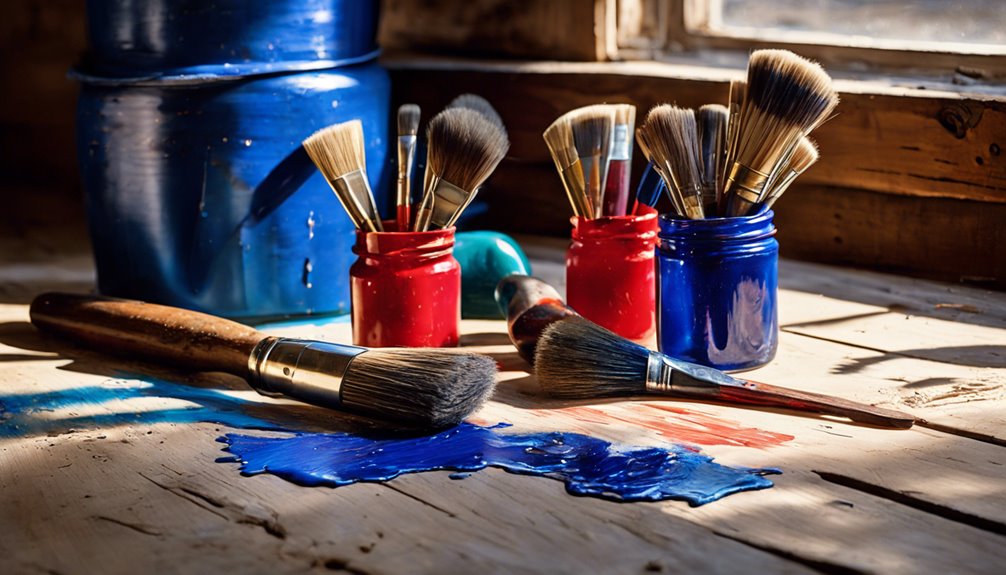
Once you've gathered your tools, it's time to test various paint removal methods to find the most effective approach for your wood floors. Start by applying different paint removal techniques on a small, inconspicuous area. You might try using a solvent, a scraper, or a natural solution like vinegar. After each application, assess the results and check for any damage to the wood. Remember to follow safety precautions—wear gloves and goggles, and maintain proper ventilation. Take notes on what works best, as this will help streamline your process. By experimenting and documenting your findings, you'll gain the confidence to tackle the entire floor, freeing it from unwanted paint while preserving its beauty.
Using Heat to Remove Paint
One effective method for removing paint from wood floors is by using heat, which can soften the paint and make it easier to scrape away. Here are three ways to use heat for paint removal:
- Heat Guns: These tools provide concentrated heat to specific areas, making paint bubble up for easy scraping.
- Infrared Technology: This method uses infrared light to penetrate and soften paint layers without damaging the wood underneath.
- Hot Air Blowers: Similar to heat guns but often more versatile, they can be used to gently warm up larger areas.
Whichever method you choose, guarantee you maintain a safe distance to avoid scorching your wood floors. With patience and the right tools, you can reclaim your beautiful wood surfaces.
Chemical Paint Strippers
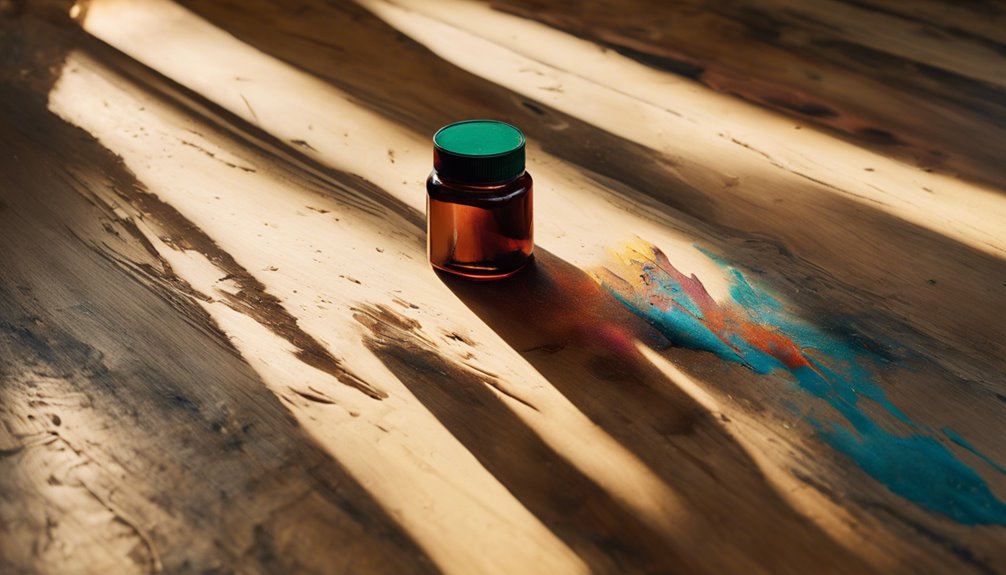
When you need to remove paint from wood floors quickly and effectively, chemical paint strippers can be a strong option. However, it's crucial to prioritize chemical safety when using these products. You can find eco-friendly options that are less harsh on the environment and your health.
| Type of Stripper | Chemical Safety | Eco-Friendly Options |
|---|---|---|
| Solvent-Based | Moderate Risk | Some Available |
| Caustic-Based | High Risk | Limited Availability |
| Bio-Based | Low Risk | Widely Available |
Before applying any stripper, always test it on a small area. Confirm the room is well-ventilated, and wear protective gear to keep yourself safe while achieving a paint-free floor.
Scraping Techniques
Scraping paint off wood floors can be a satisfying and effective method, especially for thicker layers of paint. To get started, you'll want to choose the right scraping methods and scraper types. Here are three options to evaluate:
- Putty Knife: Ideal for smaller areas, this tool allows for precision and control.
- Wide Blade Scraper: Perfect for larger surfaces, it helps you cover more ground quickly.
- Oscillating Multi-Tool: A versatile option that can tackle various paint layers with finesse.
When using these tools, always work in the direction of the wood grain to avoid damage. Remember to keep the scraper at a slight angle for the best results and a smoother finish. Happy scraping!
Cleaning and Finishing Touches
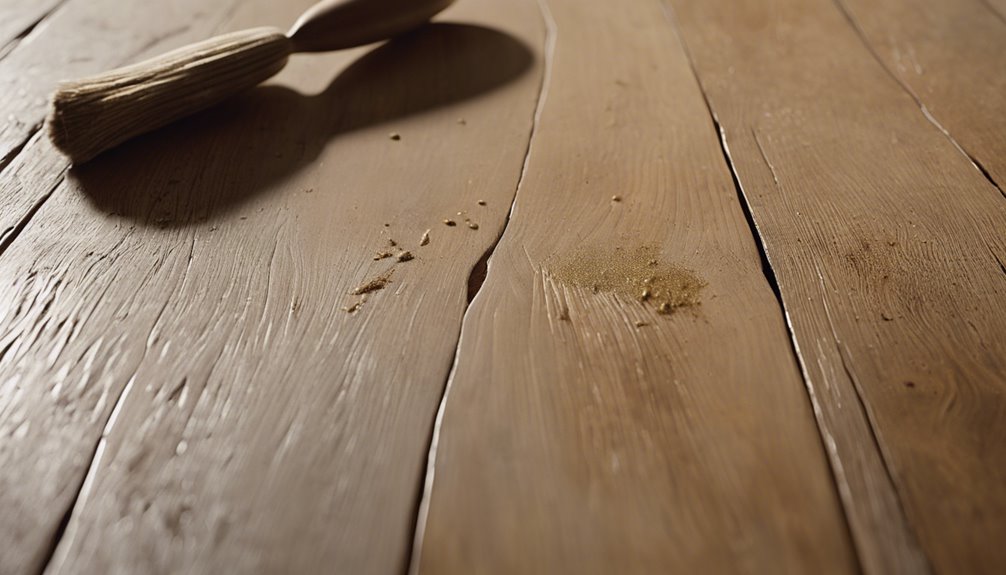
After you've effectively scraped off the paint, the next step is to clean the floor and apply any finishing touches needed to restore its original beauty. Use appropriate cleaning solutions, like a mixture of warm water and vinegar, to remove any residue.
Here's a simple table to guide you through cleaning and finishing techniques:
| Step | Action | Purpose |
|---|---|---|
| Clean | Use a cleaning solution | Remove any leftover paint |
| Dry | Wipe with a dry cloth | Prevent moisture damage |
| Finish | Apply a wood polish | Restore shine and protection |
These finishing techniques will not only enhance the look of your wood floor but also help maintain its integrity for years to come.
Preventing Future Paint Spills
To prevent future paint spills, always use drop cloths to cover your wood floors. Designate specific areas for painting to keep the mess contained and manageable. By taking these simple steps, you can protect your floors and minimize clean-up efforts later.
Use Drop Cloths
Using drop cloths is one of the simplest yet most effective ways to prevent future paint spills on your wood floors. By making this small investment, you can save yourself a lot of hassle later. Here are some drop cloths benefits to evaluate:
- Protection: They shield your floors from paint drips and splatters.
- Easy Cleanup: You can simply fold or roll them up after use, making cleanup a breeze.
- Versatile: Drop cloths come in various materials, like canvas or plastic, allowing you to choose materials that suit your project best.
When choosing materials, think about durability and absorbency. With drop cloths in place, you'll enjoy a more freedom-filled painting experience without the worry of damaging your beautiful wood floors.
Designate Painting Areas
Designating specific painting areas can greatly reduce the risk of paint spills on your wood floors. By creating designated zones for your painting projects, you limit the potential mess to a controlled space. Start by selecting an area away from high-traffic zones, and consider using paint barriers, such as painter's tape or drop cloths, to define these boundaries clearly. This not only keeps your wood floors protected but also enhances your focus while painting. Make sure you communicate these designated zones to anyone else in the home, so they know to steer clear during your project. With these simple steps, you can enjoy your creative freedom without worrying about damaging your beautiful wood floors.
Frequently Asked Questions
Can I Use Vinegar to Remove Paint From Wood Floors?
You might wonder about vinegar's effectiveness in removing paint from wood floors. While vinegar is a natural cleaner and can help with certain stains, it's not the best option for paint removal. It's crucial to prioritize wood floor care; using harsh chemicals or abrasive methods can damage the finish. Instead, consider specialized paint removers or gentle scraping techniques. Always test any solution on a small, inconspicuous area first to avoid damage.
What Type of Wood Is Most Resistant to Paint Damage?
When considering wood that's most resistant to paint damage, hardwood types like oak and maple stand out. These woods have a tighter grain, which limits paint adhesion and makes it less likely for the paint to penetrate deeply. If you're planning to paint, using these hardwoods can help minimize future issues. Just remember, proper surface preparation is key to ensuring the best outcome, regardless of the wood type you choose.
How Long Should I Wait Before Refinishing After Paint Removal?
Imagine your wood floors like a canvas, waiting to be reborn. After removing paint, give the surface time to breathe. Typically, you should wait at least 24 to 48 hours for the paint to cure fully before starting the refinishing timeline. This guarantees any lingering solvents evaporate, allowing for a smoother finish. Patience is key here—allow your floors to reclaim their natural beauty without rushing the process!
Will Paint Removal Damage My Floor's Finish?
When you're considering paint removal techniques, it's natural to worry about damage to your floor's finish. If you use gentle methods and prioritize floor finish protection, you can minimize risks. Avoid harsh chemicals or abrasives that can strip the finish. Instead, opt for safe, effective solutions that lift paint without compromising your beautiful floors. Always test a small area first to guarantee you're not causing any unintended harm.
Can I Use a Pressure Washer to Remove Paint?
Using a pressure washer for paint removal can feel like wielding a powerful storm, but it's not always the best choice. While pressure washer effectiveness might seem appealing, it's important to take into account the potential damage to the surface beneath. Paint removal techniques like scraping or using chemical strippers are often safer and more precise. If you're looking for freedom from unwanted paint, explore those options before resorting to high-pressure water.

